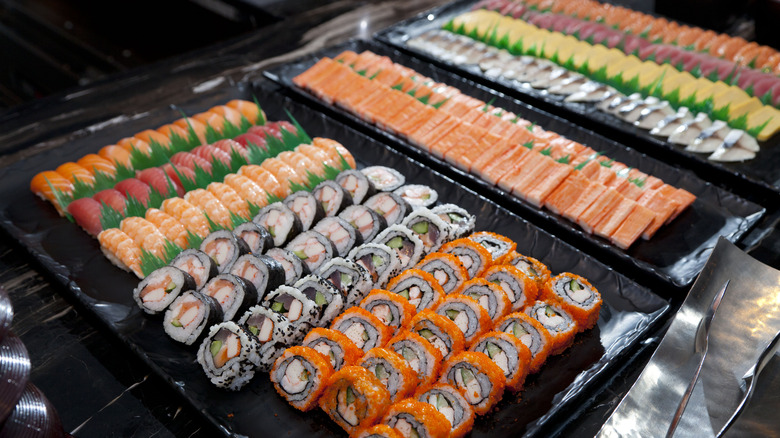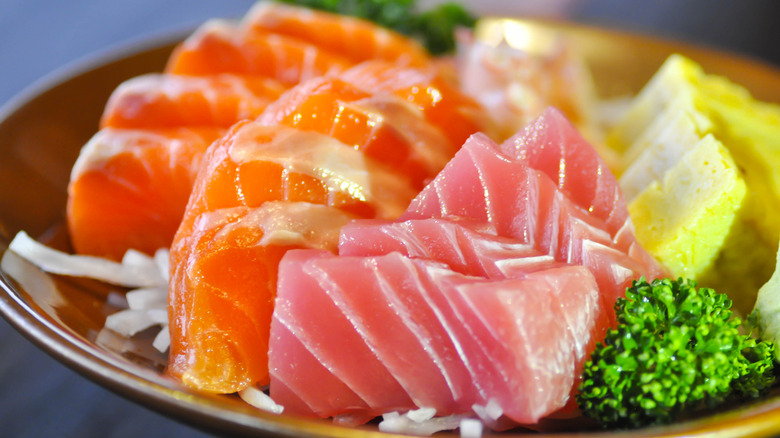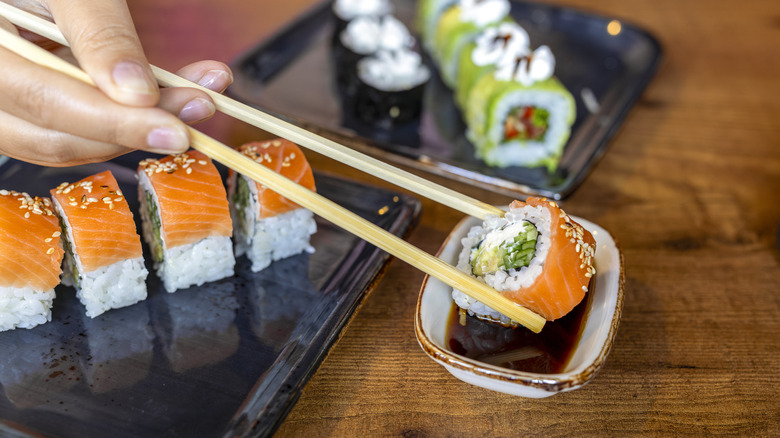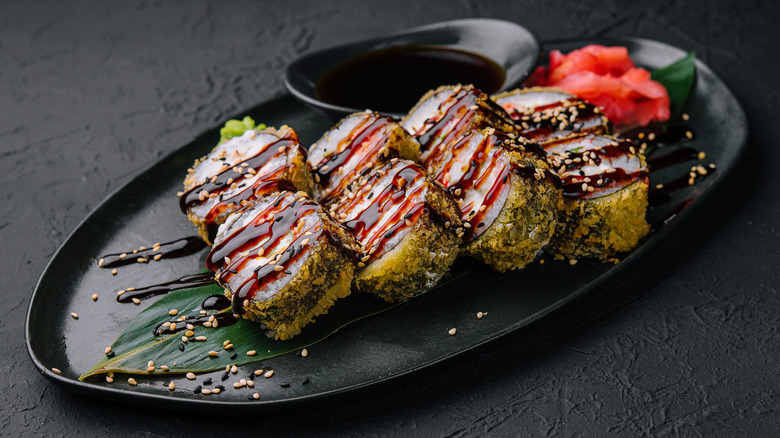The Most Profitable Strategy For An All-You-Can-Eat Sushi Buffet
Dining out sure isn't getting any cheaper, which means it's time for foodies to work smarter, not harder, when it comes to pursuing their favorite pastime. For the price-conscious diner, the all-you-can-eat buffet has long been an ace in the hole. Though the concept was originally designed in the 1940s to keep Las Vegas casino patrons fed without encouraging them to leave the premises, today's versions can be surprisingly cost-effective — so long as you've worked out a game plan beforehand, that is.
The sushi buffet is one of the finest innovations in the all-you-can-eat buffet sphere. This culinary crossover is a great place to indulge in a pricier favorite while saving a few bucks for the next dining adventure — and you don't have to compromise your standards, either.
The great thing about the sushi buffet is that you're looking at an average price of $25 to $30 for the entire meal, compared to the average price of a sushi roll, which is about $12 to $15 per roll. Of course, any savvy diner knows that all-you-can-eat buffets employ certain tricks of the trade to make sure you get sidetracked into those heavy carbs or sugary soft drinks. However, with the right pre-buffet mindset, getting the most bang for your buck at an all-you-can-eat sushi buffet is nothing more than a matter of mind over maki.
Sashimi is your friend
Planning your trip to the sushi buffet requires a quick rundown of assets vs. liabilities. Eating a lot of sushi means eating a lot of rice, and since rice is a carb, that's a major liability in a buffet situations, making you feel more full. So, the best way to rev up your appetite at the sushi buffet is to case the joint for any sashimi options.
While sashimi is not technically sushi — the term "sushi" actually refers to the rice itself, after all — it's often served as an appetizer in sushi bars across the world. If you're not sure what to look for, you're after those thinly-sliced squares of tuna, salmon, or other neatly protein you can eat in one bite, if you're eating sushi like a pro. When you see those lovely, jewel-toned slices of fish, you'll notice there's not a grain of rice to be found, ultimately leaving you some extra space to indulge in maki and uramaki rolls later.
There are logistical reasons to start with sashimi if you're looking for the most economical way to plow through a big sushi meal, but remember that sashimi is also a traditional appetizer in sushi restaurants for the express purpose of whetting your appetite. Plus, it's great way to sample the proteins on tap so you can make more informed decisions later.
Vary your textures
Aside from feeling uncomfortably full, one of the biggest killers of appetite is a lack of textural variety. While the silky texture of sliced tuna and the rice's slight heft are among the primary reasons sushi is so luxurious, you can tap out pretty quickly if you aren't thinking about how to mix and match crispy and crunchy.
Pushing yourself to detect textural nuances among different cuts of fish or rice preparations is a great way to appreciate sushi as an art form. However, if your goal is consumption over appreciation, you're going to want to check the goods. Your best friends will be ingredients that add some kind of contrast to the velvety rice and fish. For example, rolls that incorporate thin julienned cucumber will provide a refreshing crunch, and rolls that come topped with a thin wedge of lemon or lime will add a bit of toothsome chew.
Even at all-you-can-eat buffets, sushi chefs use their craft to explore many different combinations of flavors and textures. Thus, the best way to get the most out of your sushi buffet experience is to follow suit. If it has some crunch, chew, or pop, give it a whirl to avoid textural burnout.
Avoid the heavy stuff
When experimenting with textural contrast, it's easy to get distracted by those deep-fried tempura rolls, or sushi stuffed with cream cheese. Though you may be tempted to throw a Vegas roll into your rotation, there are some solid reasons why you should reconsider that order when going for maximum consumption.
For starters, the tempura frying process is going to add more carbs — aka liabilities — to the party, while also adding a higher fat content to the table. Though deep-frying a sushi roll in tempura batter is delicious, deep-frying anything is a one-way ticket to a food coma sooner rather than later. The same holds for cream cheese, so leave those Philly rolls alone when making an attempt to improve your sushi profit margin.
Tempura batter and cream cheese are going to be the most common obstacles that will get in the way of going for broke at a sushi buffet, but that doesn't mean they're the only ones. Keep an eye on that menu to make sure you avoid any other ingredients that add more carbs or fat to your sushi eating journey. Remember to keep things lean and mean and you'll be just fine.



